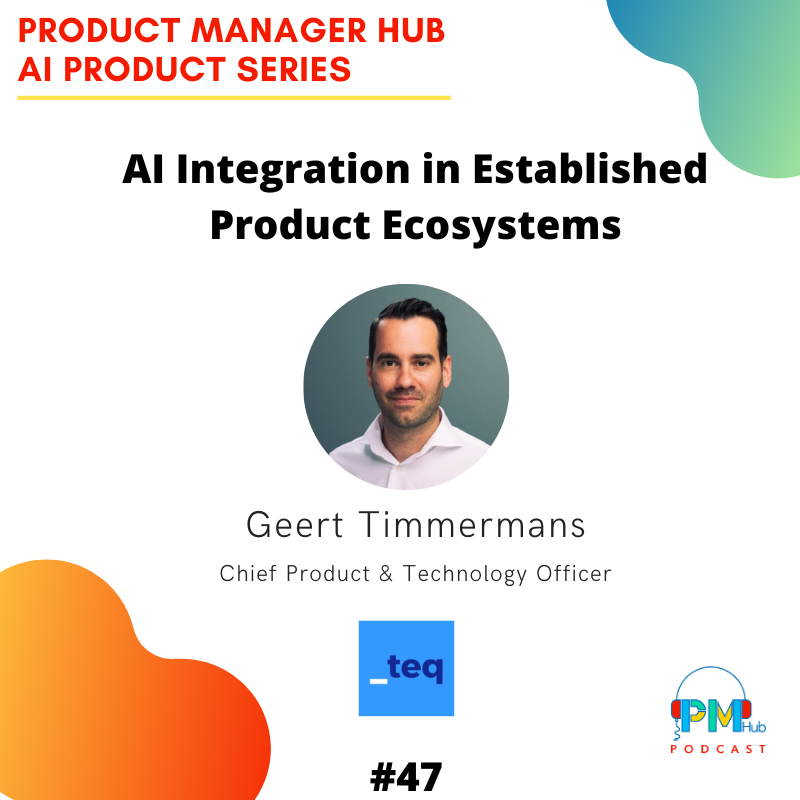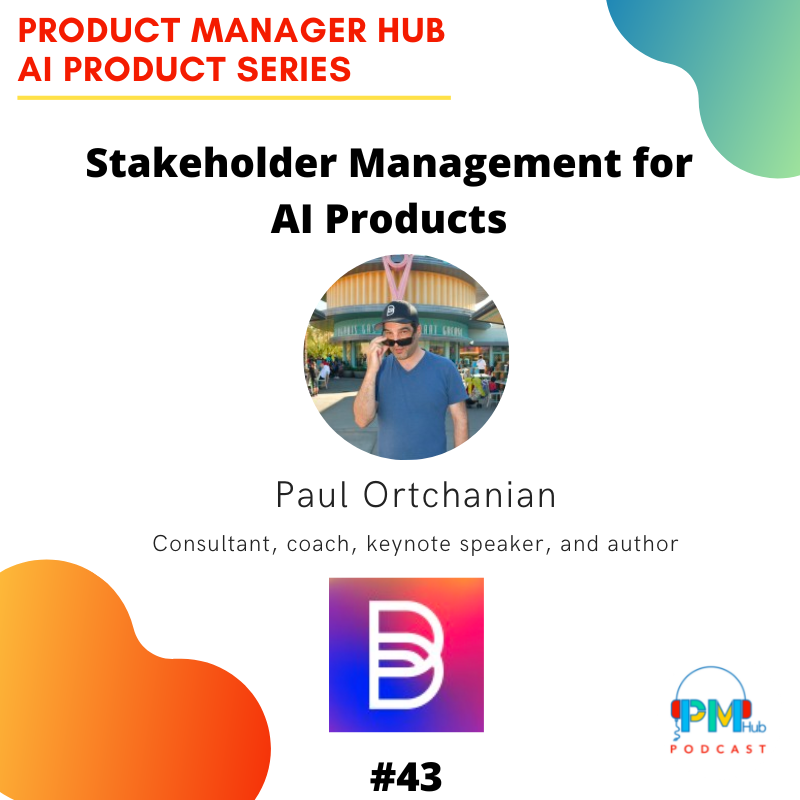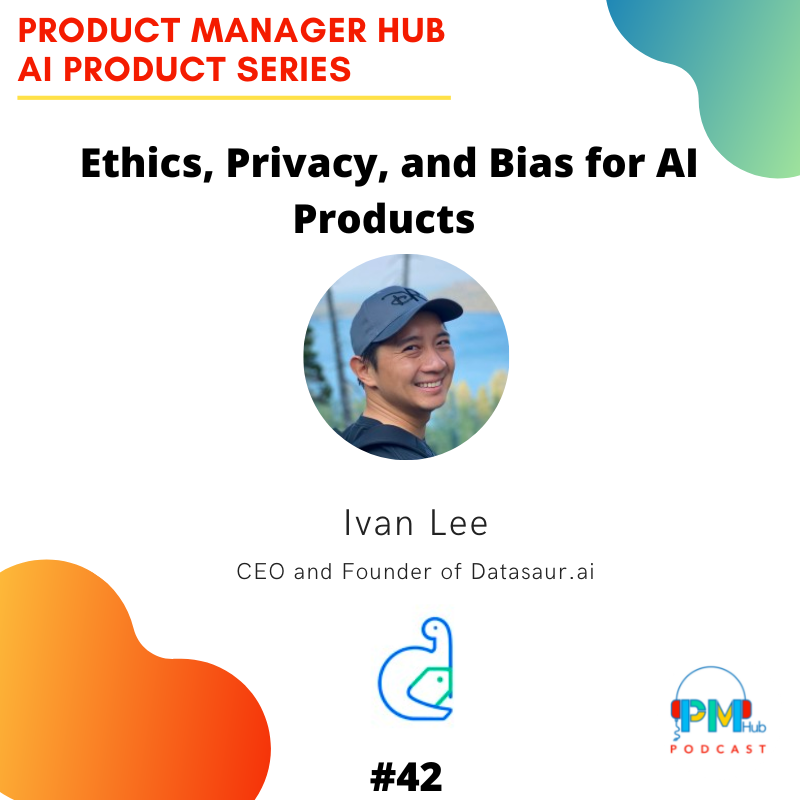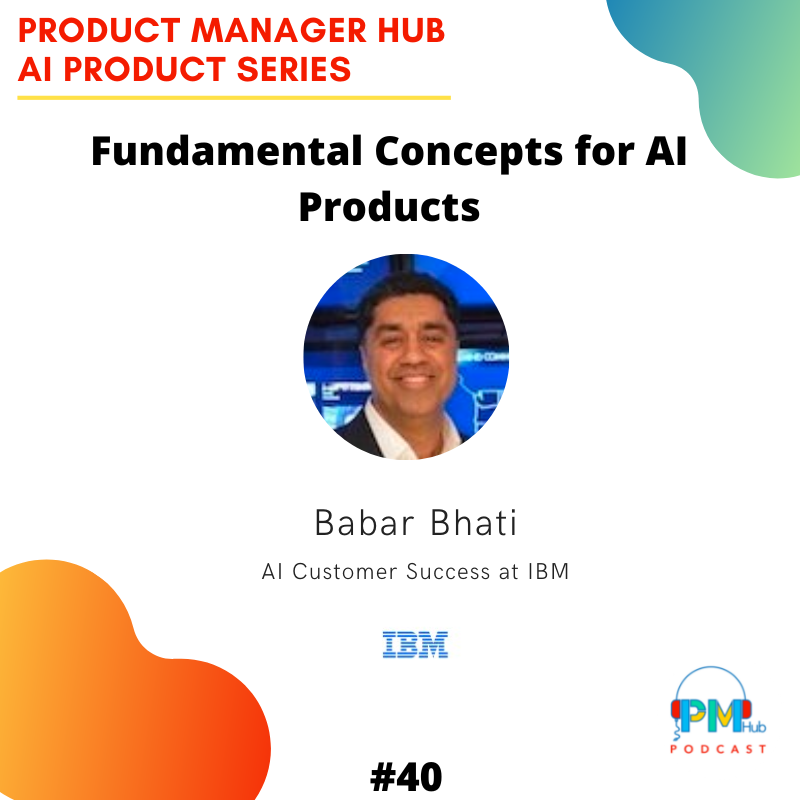Discover Product Manager Hub (PM Hub)
Product Manager Hub (PM Hub)

Product Manager Hub (PM Hub)
Author: Cyrus Shirazian
Subscribed: 41Played: 456Subscribe
Share
© 2022 - Product Manager Hub (PM Hub) by Cyrus Shirazian
Description
PM Hub Podcast is a weekly podcast for Product people and tech entrepreneurs to learn from top experts in the field. Subscribe now so you don’t miss an episode! Questions? Comments? Feedback? Reach out to your host Cyrus Shirazian on Twitter at @ceslamian or LinkedIn
48 Episodes
Reverse
Summary
Summary
In this conversation, Cyrus and Lauren discuss the intersection of Agile and data science, specifically focusing on the challenges of shipping AI-enabled products quickly. They emphasize the importance of democratizing AI within organizations and the need for product managers to understand AI and ML concepts. They also discuss the prioritization of AI ML feature sets per quarter and the balance between quick wins and long-term strategic initiatives. Lauren shares her recommendations for getting buy-in and support from leadership, including listening, scenario planning, and making informed decisions.
Takeaways
Democratizing AI within organizations is crucial for enabling more people to understand and work with AI and ML.
Product managers should prioritize AI ML feature sets based on business goals and market expectations.
Balancing quick wins and long-term strategic initiatives is important for delivering outcomes and driving growth.
Getting buy-in and support from leadership requires listening, scenario planning, and making informed decisions.
Understanding the constraints and goals of different teams and stakeholders is essential for successful product management in the AI ML space.
Chapters
00:00 Introduction and Background
03:25 Challenges of Delivering Business Value Quickly
06:52 Democratizing AI within Organizations
11:05 Scoping AI/ML Feature Sets for Revenue Outcomes
14:12 Staying Up-to-Date with New Technologies
27:40 Incorporating AI into Product Strategies
28:54 Aligning Organizational Expectations and Goals
30:09 Understanding Constraints and Goals
33:10 Planning and Execution
36:04 Balancing Quick Wins and Long-Term Strategic Initiatives
40:17 Gaining Buy-In from Leadership
43:10 Democratizing Knowledge about AI and ML
Keywords
Agile, data science, intersection, challenges, shipping, AI-enabled products, democratizing AI, product managers, prioritization, feature sets, quick wins, long-term strategic initiatives, buy-in, leadership
Summary
Geert Timmermans, CPTO at StoryTech, shares his background and experience in integrating AI into product development. He emphasizes the importance of bridging the gap between engineering and product teams to maximize the value of AI. The challenges organizations face when integrating AI include the need for the right skillset, avoiding gimmicks, and focusing on the value AI brings to customers. Timmermans suggests a strong focus on product discovery and continuous discovery to ensure AI is integrated effectively. He also highlights the importance of giving engineers the freedom to experiment and collaborate with the product team. AI should be seen as an enabler and an opportunity to enhance and augment human capabilities, rather than a threat or replacement. It can assist in various industries, such as healthcare and marketing, by speeding up processes and improving quality. The adoption of AI requires a mindset shift and a willingness to upskill. It is important to build AI architecture in a way that allows for flexibility and the ability to plug in different models and suppliers. Data readiness is a challenge for many organizations, and a phased approach to AI implementation can help overcome this by starting small and gradually scaling up.
Takeaways
Bridging the gap between engineering and product teams is crucial for successful AI integration.
Product discovery and continuous discovery are essential for effective AI integration.
Avoid gimmicks and focus on the value AI brings to customers.
Give engineers the freedom to experiment and collaborate with the product team. AI should be seen as an enabler and an opportunity to enhance and augment human capabilities.
AI can assist in various industries by speeding up processes and improving quality.
The adoption of AI requires a mindset shift and a willingness to upskill.
Building AI architecture with flexibility and the ability to plug in different models and suppliers is important.
Data readiness is a challenge, and a phased approach to AI implementation can help overcome this.
Chapters
00:00 Geert’s Background and Role as CPTO
07:06 Challenges of Integrating AI into Established Product Ecosystems
10:08 The Importance of Collaboration between Engineering and Product Teams
12:27 Product Discovery and Continuous Exploration for AI Integration
14:23 AI as a Foundational Aspect of Product Development
14:49 Introduction and Product Discovery
19:20 Collaboration between AI and Software Development Teams
36:09 The Phased Approach to AI Integration
40:39 The Challenges and Realities of AI
48:10 Data Quality and IP Protection
51:47 AI as an Enabler, Not a Threat
Keywords
Geert Timmermans, CPTO, StoryTech, background, integrating AI, product development, engineering, product teams, skillset, value, challenges, product discovery, continuous discovery, engineers, collaboration, AI, enabler, opportunity, enhance, augment, assist, healthcare, marketing, adoption, upskill, architecture, flexibility, data readiness, phased approach
Summary
In this conversation, Cyrus and Ivan discuss various topics related to NLP (Natural Language Processing) and its impact on AI. They cover Ivan’s background in AI and NLP, pivotal moments in his career, the current state of the NLP industry, best practices for data collection and NLP-powered products, the challenges of scaling LLM-POCs (Large Language Models Proof of Concepts) into production, and the ethical considerations of NLP. They also touch on the future of NLP and AI, including the potential for AI agents and the role of NLP in unlocking human creativity.
Takeaways
NLP is revolutionizing AI by enabling machines to understand and process human language.
Data collection and the design and build of NLP-powered products require careful consideration and alignment with business metrics.
Labeling data for NLP models can be time-consuming and expensive, and automation tools can help save time and money.
Ensuring consistency and accuracy in NLP models is crucial, especially when dealing with multiple correct answers and user intent.
The future of NLP and AI holds exciting developments, such as multimodal language understanding and unlocking human creativity.
Ethical considerations are essential in the application of NLP, and measures must be taken to protect user privacy and ensure fairness.
Integrating NLP into products and services requires a positive and forward-thinking mindset, embracing the potential of NLP to enhance user experiences and drive innovation.
Chapters
00:00 The Current State of NLP Industry
00:15 Pivotal Moments in Ivan’s Career
03:24 Advancements in NLP and LLMs
14:27 Data Labeling and Saving Time and Money
17:54 Impact of Lawsuits and Real-Time Use Cases on User Experience
18:51 Future-Proofing Products and Fine-Tuning Models
19:52 Standardization and Automation in Model Development
21:19 Scaling LLM-POCs into Production Environments
23:03 Complexity of Multiple Truths and User Intent in NLP
24:20 Best Practices for Labeling and Model Training
27:01 Case Study: Impact of DataSaur’s NLP Technology on the Legal Industry
28:55 Ensuring Consistency and Accuracy in Model Output
34:14 Ethical Considerations in NLP and AI
39:04 Exciting Developments in NLP and AI
45:18 Advice for Integrating NLP into Products and Services
Summary
In this conversation, Arnon discusses the ethical concerns surrounding AI in healthcare, including privacy and data protection, explainability and liability, and the balance between regulations and innovation. He also explores the role of clinicians in the adoption of AI, the importance of informed consent and patient education, and the need for multidisciplinary discussions to navigate the ethical challenges. Arnon envisions the widespread adoption of personalized medicine integrated with telemedicine as the most significant change in healthcare as a result of AI in the next decade.
Takeaways
Privacy and data protection are paramount in AI healthcare, and regulations like HIPAA and GDPR need to be adaptable to the evolving AI landscape.
Explainability and liability are crucial in building trust and ensuring that AI is used as a tool to enhance human decision-making, not replace it.
Clinicians play a vital role in ensuring the ethical use of AI in medicine and should engage in multidisciplinary discussions with AI experts, ethicists, and legal professionals.
Patient education and informed consent are essential to empower patients and ensure they have a say in how their data is handled.
The future of healthcare will likely involve the widespread adoption of personalized medicine integrated with telemedicine, breaking down geographic and economic barriers to high-quality care.
Chapters
00:00 Introduction and Background
03:01 Ethical Concerns in Healthcare AI
06:04 Privacy and Data Protection
07:25 Explainability and Liability
08:28 Balancing Regulations and Innovation
10:40 Using Synthetic Data
11:58 Addressing Bias in Healthcare AI
19:21 The Role of Clinicians in AI Healthcare
25:03 Informed Consent and Patient Education
30:18 Educating Healthcare Institutions and Regulatory Bodies
31:44 The Evolving Role of Clinicians
35:37 Regulations and the Future of Healthcare AI
40:05The Future of Personalized Medicine and Telemedicine
In this episode with Simon O’Regan, you will learn:
What is UX for AI products and why does it matter
How does UX for AI products change depending on the type of product
Simon’s overall strategy for UX part of AI Products
Intro music by Peter Boros of The Nameless Citizens
In this episode with Paul Ortchanian, you will learn:
How do you figure out the right stakeholders for an AI product that you’re working on
What are some unique challenges for stakeholder mgmt for AI products?
Paul’s overall strategy for managing stakeholders for AI products?
Intro music by Peter Boros of The Nameless Citizens
In this episode with Ivan Lee, you will learn:
Some ethical concerns that AI products have raised for users
How can an AI PM build trust with their users
Intro music by Peter Boros of The Nameless Citizens
In this episode with Jaekob Chenina, you will learn:
Why do many AI initiatives fail?
What kind of skill sets do you need on an AI Product team and what each role does?
What are some ways to assemble an AI Product team?
Intro music by Peter Boros of The Nameless Citizens
In this episode with Babar Bhati, you will learn:
Structure of AI teams
Difference between a regular algorithm vs an AI algorithm
Main AI fields and their differences
Intro music by Peter Boros of The Nameless Citizens
In this episode with Daniel Elizalde, you will learn:
What do you consider emerging tech and why is it important
What are some myths about leveraging emerging tech
Daniel’s overall strategy for leveraging emerging tech for a business
Intro music by Peter Boros of The Nameless Citizens
In this episode with Farbod Saraf, you will learn:
What is PAD about and how it can help you in product discovery
How to effectively run product alignment meetings?
Intro music by Peter Boros of The Nameless Citizens
In this episode with Lauren Chan Lee, you will learn:
What is Product Decagon, how did it come to be and how it can help you level up your Product career
Get the free cheat sheet with all actionable tips and notes from this episode in a one-page PDF at bit.ly/pmhub37
Intro music by Peter Boros of The Nameless Citizens
In this episode with Arundhati Sampath, you will learn:
How to come up with Product ideas
How to validate Product ideas and navigate trade-offs
Challenges and best practices around Product ideas
Get the free cheat sheet with all actionable tips and notes from this episode in a one-page PDF at bit.ly/pmhub36
Intro music by Peter Boros of The Nameless Citizens
In this episode with Rapha Cohen, you will learn about:
Rapha’s insights on AI, frameworks, principles behind building great Products and Product teams
Intro music by Peter Boros of The Nameless Citizens
In this episode with Anu Bharadwaj, you will learn:
How to adopt asynchronous communication for distributed teams
How to setup the culture for distributed teams
Strategies you can apply to grow and scale your distributed team
Get the free cheat sheet with all actionable tips and notes from this episode in a one-page PDF at bit.ly/pmhub33
Intro music by Peter Boros of The Nameless Citizens
In this episode with Megan Murphy, you will learn:
Challenges around applying OKRs to set objectives
Megan’s approach on setting objectives to rally the Product team
How to align stakeholders around objectives
Intro music by Peter Boros of The Nameless Citizens
In this episode with Rina Whittaker, you’ll learn:
What is leading curiosity and why is it important for Product people
How to strategize to be more curious
Caveats and challenges around curiosity
Get the free cheat sheet with all actionable tips and notes from this episode in a one-page PDF at bit.ly/pmhub32
Intro music by Peter Boros of The Nameless Citizens
In this episode with Mark Rabo, you’ll learn:
Why is it important to have a plan when onboarding as a PM?
What are some high-level mindsets when onboarding into a PM role?
What is Mark’s overall strategy for onboarding as a PM? Share with us the 7 pillars of onboarding
Get the free cheat sheet with all actionable tips and notes from this episode in a one-page PDF at bit.ly/pmhub25
Intro music by Peter Boros of The Nameless Citizens
In this episode with Mayank Yadav, you’ll learn:
How to get traction for your marketplace
How to reach product-market fit for your marketplace
How to create a growth playbook for your marketplace
Intro music by Peter Boros of The Nameless Citizens
In this episode with Hope Gurion, you will learn:
What is a Product Vision and why does it matter to have a Product Vision?
What are the elements of a Product Vision?
What are some use cases/applications of a Product Vision?
Get the free cheat sheet with all actionable tips and notes from this episode in a one-page PDF at bit.ly/pmhub30
Intro music by Peter Boros of The Nameless Citizens



























The technology of human emotion recognition with AI is truly groundbreaking. The experience of using this technology is nothing short of remarkable - it's like having a personal emotional intelligence coach at your fingertips. The accuracy and speed at which it can detect and interpret emotions is truly impressive, making it a valuable tool for improving communication and understanding in various settings, for more information visit https://programminginsider.com/technology-of-human-emotion-recognition-with-ai/ . The user-friendly interface makes it easy to navigate and utilize, making the overall experience seamless and enjoyable. I highly recommend exploring the possibilities of this technology for anyone looking to enhance their emotional awareness and communication skills.